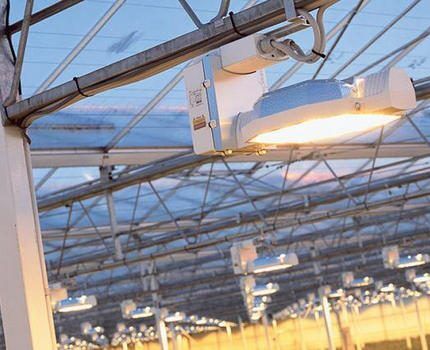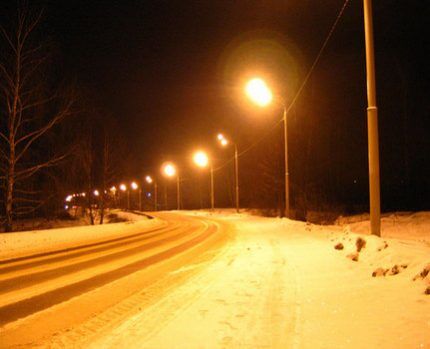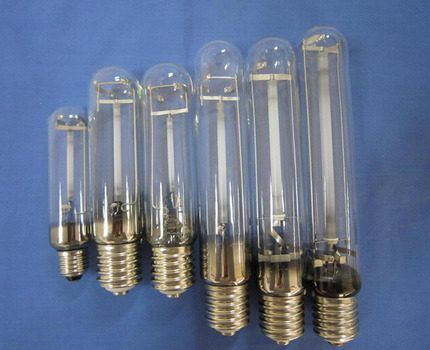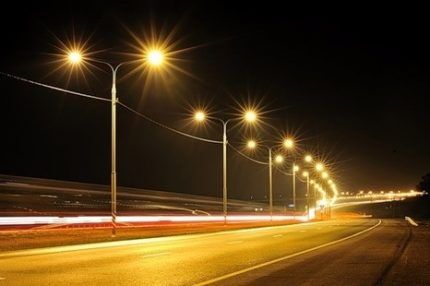Sodium lamps: varieties, technical parameters, scope of application + selection rules
Economical sodium lamps are a practical light source for large spaces, where the main task is not color accuracy, but economical, rich, highly efficient and bright full-fledged radiation.
The modules are reliable, not too demanding on environmental conditions and are operationally stable. With their help, you can reduce energy costs without sacrificing the quality and density of the outgoing light flux.
However, in order for the lamps to cope with their task as efficiently as possible, they must be selected correctly in accordance with the intended conditions of use. In order not to get confused in the diversity, we suggest that you familiarize yourself with the classification of sodium aggregates, find out their pros and cons, scope of application and selection rules.
The content of the article:
- General description of lighting fixtures
- Classification of sodium aggregates
- Nomenclature division of devices
- The main advantages of sodium aggregates
- Main product disadvantages
- Danger to humans and the atmosphere
- Area of application of devices
- How to choose the right light source
- Conclusions and useful video on the topic
General description of lighting fixtures
Sodium products are progressive, modern and economical equipment. The main working element in them is sodium vapor.
Design features of the modules
The whole process takes place in a special cylindrical burner tube consisting of aluminum oxide.
The elements that carry out the radiation are placed in a cylinder made of durable glass, equipped with the most popular threaded sockets E27 or E40.

The resonant radiation generated in the process has a specific yellow-orange color, called monochromatic.
This means that, despite the brightness, density and saturation, the light flux does not provide good color rendition.
In addition, being at twice the mains frequency, the modules flicker significantly, which makes them absolutely unsuitable for lighting residential premises.

Sodium light sources consist of a heat-resistant glass bulb of elliptical or cylindrical shape. Inside there is a working aluminum burner, equipped with electrodes on both sides.

This material has high physical characteristics and is characterized by good operational resistance.
It interacts correctly with sodium vapor and has the unique ability to transmit about 90% of the produced light energy without being destroyed.
In addition to sodium compounds, there is mercury and argon inside the discharge tube.

The flask is equipped with special gaskets. They take care of maintaining a vacuum in the interior of the light bulb and preventing oxygen from entering the burner.
This increases the level of operational safety of the devices, since during operation the discharge tube becomes very hot and reaches almost fantastic levels of 1300°C.
In this case, even a very small amount of air getting inside can destroy the integrity of the module and provoke a dangerous situation for people nearby.
How the products work
The operating principle of the sodium device is based on arc discharges. As a result of the pulsed voltage generated in the inner tube, they create a rich visible glow.

In sodium vapor, which is responsible for the formation of a gas-discharge environment inside the flask, the red spectral glow predominates.
Thanks to this feature, lamp units create outgoing light in shades such as:
- yellow;
- orange;
- red in a wide variety of shades.
Immediately after activation, sodium devices burn weakly and dimly, because the bulk of energy resources are spent on high-quality heating of the working burner.
The light flux acquires the necessary brightness, saturation and strength only after 5-10 minutes, when the temperature of the internal burner reaches the level necessary for correct operation.
Nuances of the device launch system
All sodium type products require a starting system. It is designed to provide optimal ignition and convenient adjustment of current flow. There are currently two types of ballasts on the market.

Option #1. This is a ballast unit, designed to operate at a mains voltage level of 220 V. It has a simplified design, is sold at a reasonable price and is one of the budget options for related equipment.
Option No. 2. This is a more modern, progressive electronic ballast unit that does not have an ignition device in its design.
Stabilizes power, significantly increases the efficiency of light output, eliminates flicker that is unpleasant for the eyes and extends the service life of a sodium device.

The only disadvantage of the product is its higher price than that of ballasts. However, experts say that the electronic device quickly pays for itself and significantly increases the comfort of controlling the lighting system.
Classification of sodium aggregates
According to the basic classification, lamps differ from each other in the level of internal partial pressure of sodium vapor.
Products with low performance are called low pressure modules (LPND). Devices showing large numbers are high pressure devices.
Each category has its pros and cons.Based on them, the user can easily choose the most successful and optimal lighting device for himself.
Distinctive features of low pressure modules
Low pressure products (LPPD) have several specific features that set them apart from the product line of similar devices.
They are equipped not with a simple glass flask, but with a high-strength borosilicate one. This is due to the aggressive effect of sodium vapor on glass surfaces.

The effective operation of NLND directly depends on the ambient temperature. Therefore, to ensure optimal operating conditions, the light bulb is placed in an outer glass flask, which acts as a kind of thermos and protects the light source from negative influences.
Why are high pressure lamps interesting?
High pressure sodium modules (HPS) are renowned for their superior color rendering and phenomenal efficiency. Their light output at a power of 30-1000 W reaches 160 lm/W, and their service life often exceeds 25,000 hours.
Due to the compact size of the luminous body and the unprecedented brightness of the output light flux, the scope of application of the products is very wide.

Products must be operated with an inductive or electronic ballast.Ignition is carried out using a special device (IZU), which provides pulses of up to 6 kW.
From the moment of activation until full light of the required brightness appears, it takes from 3 to 5 minutes.
Nomenclature division of devices
The generally accepted domestic nomenclature of lighting sources distinguishes four types of sodium devices. They are available in different modifications and are intended for specific tasks. To understand where to use this or that type of lamp, you need to know about their distinctive features.
What are DNATs?
DNaT are tubular arc modules with a screw base and a transparent quartz glass bulb. They have a cylindrical shape and differ from analogues in a wide power range.
They demonstrate a good level of efficiency and are included in the category of economical light sources.

The products provide high-quality street lighting with pronounced contrast visibility in various weather conditions.
Suitable for placement on intercity highways, in tunnels, at airfields, etc. They show excellent results when used in greenhouses, greenhouses and greenhouses.

DNaMT have the same parameters, but are produced in an ellipsoidal shape and are equipped with a frosted glass bulb to create softer diffused lighting.
How do DNAZ work?
DNaZ are a light source equipped with a bulb with a built-in reflector made of mirror aluminum film, hermetically located on the inner walls of the device. They are manufactured in the shape of an ellipse and are equipped with a classic screw base.

They are widely used in the agricultural industry. They successfully imitate natural light and ensure active growth and development of vegetable and ornamental crops growing in greenhouses.
What is the difference between DNAS
DNaS differs from all other lamps in the presence of a coating of light-scattering substance on the inner surface of the bulb. This technical solution allows the module to be used to directly replace outdated and environmentally hazardous gas-discharge mercury lamps.
DNAS modules are most widely used in research laboratories, medicine, the chemical industry and other related industries.
The main advantages of sodium aggregates
The most interesting, important and noteworthy characteristics of sodium-type light sources are the following:
- unprecedentedly high level of light output – up to 150 lm/W for high-pressure modules and about 200 lm/W for low-pressure lamps;
- long operating period – from 12,000 to 32,000 hours without loss of quality and light intensity;
- economical operation – reduction in basic energy consumption and 1.5-2 times reduction in maintenance costs for the lighting installation;
- wide operating temperature range – the products function absolutely correctly in the range from -60°C to +40°C.
Sodium light sources are twice as efficient as conventional fluorescent lamps of the same power.

This is due to the design features of the products and the compact, small-sized emitter, which can very easily and without delay direct light rays in the required directions.
Main product disadvantages
In addition to the impressive list of pros and cons, sodium light sources have several specific features with a minus sign.
Among them the following positions stand out:
- specific color range, changing during long-term operation - does not allow the modules to be used in rooms where high requirements regarding color rendering are established;
- dependence on weather conditions quality and saturation of the light flux - at cold temperatures, the radiation noticeably deteriorates and loses intensity;
- high level of sensitivity to power supply parameters – in case of serious system fluctuations, it is undesirable to use the devices; operation is permissible only in networks with equal voltage, where minor fluctuations are only occasionally observed;
- need for additional security elements – during the combustion process, a leakage of sodium atoms is formed, and to avoid this, a single-crystal discharge tube is used together with the lamp;
- duration of initial ignition – when activated, the lamp does not light up immediately and produces a stable light output only after 6-10 minutes;
- problematic connection and subsequent maintenance of ballasts, which have impressive dimensions and are subject to loss of up to 60% of power;
- pulsation of light flow with a network frequency of 50 Hz;
- stable growth in power consumption throughout the entire service life - sometimes the figures exceed the initial figures by 35-40%.
Considering all these points, experts do not recommend using lamps for household lighting systems. At home, sodium light sources simply will not be able to perform properly.

But where economical, powerful, rich light is required without any complaints about clear and correct color rendering, the modules will perform excellently and cope with the assigned tasks perfectly.
Danger to humans and the atmosphere
Since sodium light sources, due to their low color rendering, are not used in rooms where people spend a lot of time, they do not have too great a negative impact on human health.
However, they cannot be called completely safe and environmentally friendly due to the toxic mercury they contain.

Disposing of used products in trash containers is strictly prohibited.If the integrity of the flask is damaged, mercury escapes into the surrounding space, creating toxic fumes around it that are 20 times higher than the permissible safe standards.
The rules for disposing of sodium lamps are the same as for fluorescent lamps; for more details, see this article.
Area of application of devices
Poor color rendering accuracy does not allow the use of sodium modules in residential premises, but for the street this parameter is practically unimportant, so NLs are used there most often.

With the help of NL, they create economical and highly efficient systems for lighting large areas, avenues, highways and suburban thoroughfares.
NL is placed in devices intended for background lighting and illumination:
- tunnels, sports facilities and container sites;
- historical monuments and architectural structures;
- airports, train stations and other places where people do not spend a lot of time;
- workshops, production and warehouse premises, where no claims are made to the quality of color rendering;
- in greenhouses, winter gardens and greenhouses to increase the growth rate and basic yield of plants, ornamental flowers, vegetables and berries.
In all of the above electrical systems, NLs operate efficiently and provide the proper level of illumination with minimal energy consumption.
How to choose the right light source
Low color rendering quality and strong flicker make sodium modules unsuitable for domestic use and permanent lighting of residential premises.
But this is not a reason to refuse to use such economical and efficient light sources in other areas.

You just need to clearly define the tasks that need to be solved and specifically select the most successful light source for them.
If you need to create a lighting system in a greenhouse or conservatory where various vegetables, herbs, berries, ornamental plants and flowers are grown, you should give preference to high-pressure products labeled DN3.
They have a 95% reflectivity and maintain these parameters at the proper level throughout the entire operational period.
The luminous flux of the lamps is not directed only downwards, as, for example, with HPS modules, but is distributed longitudinally.
This makes it possible to embed sodium products directly into the center of a shelving unit, window sill or table, from where they can throw light along the row and in both directions around it.

Simple DNLs perform well in greenhouses with minimal access to sunlight. They provide the blue and red spectral glow vital for plants, accelerating growth, development, fruiting and flowering.
When it is necessary to provide high-quality illumination of highways and increase their safety during difficult weather conditions such as thick fog or snowfall, it is worth paying attention to classic low-pressure HPS.
They consume resources economically, have a long service life of up to 32,000 hours and provide a rich and bright light flux of up to 200 lm/W.
Information about the nuances of choice and the best manufacturers of lamps for use in residential premises is given in the articles:
- Which light bulbs are best for the home: what are they + rules for choosing the best light bulb
- Choosing energy-saving lamps: a comparative review of 3 types of energy-efficient light bulbs
- Light bulbs for suspended ceilings: rules for selection and connection + diagrams for the location of lamps on the ceiling
- Which LED lamps are better to choose: types, characteristics, choice + best models
Conclusions and useful video on the topic
What is a sodium lamp, how does it work in different conditions and how does it differ from other light sources:
Detailed review of the sodium module from the German company Osram:
How to effectively illuminate plants in a greenhouse using sodium lighting products:
Sodium devices must be selected in strict accordance with the area of use. It is better to purchase products from well-known brands in a store where the goods are stored in suitable conditions and are not exposed to aggressive environmental influences.
Such a lamp will serve its entire life, will not require complex maintenance procedures and will provide a dense, rich light flow in any place convenient for the user.
Do you have experience using sodium lamps? Or want to ask questions on the topic? Please comment on the post and participate in discussions.The feedback block is located below.




A competent technical solution. Every evening I drive past an oil refinery from work, and everything there is literally studded with such lamps... for the first time I learned that they are called sodium) Their efficiency for the home is probably too low, but as a constant, economical source of light in production workshops and buildings - an ideal option, It's better not to think of it. Educational reading.
I have a lot of decorative flowers at home. For flowers, I have a balcony, which was glazed and insulated. But many of the plants are light-loving. In summer they get enough sunlight. But in winter there is not enough light for them, especially since my apartment faces north. I began to think about how to add lighting to them in the winter season. I learned about sodium lamps, which are suitable for such purposes. I hired a craftsman who installed electricity on the balcony and installed sodium light bulbs there.
By the way, in addition to brightness and high efficiency, sodium lamps have a spectrum that is perfectly suitable for most plants. For illumination of greenhouses and winter gardens, until recently and the advent of LED phyto-lamps, this was the best option. The spectrum of DNAT and DNA3 most closely corresponds to areas of daytime sunlight absorbed by chlorophyll. We use these lamps at the dacha.